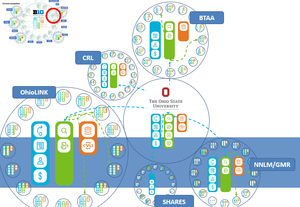The power of pull
I have written about the Power of Pull before, an interesting book by John Hagel, John Seely Brown, and Lang Davison. For a fuller discussion see the earlier blog entry (People are entry points too … redux).
Here is a short version. The authors discuss the shift from managing ‘knowledge stocks’ to participating in ‘knowledge flows’ as patterns of work and interaction change in a network environment. I was particularly struck by their discussion of information overload.It’s not so much about finding which information is most valuable, as many of those who fret about information overload would have it. Improving return on attention is more about finding and connecting with people who have the knowledge you need, particularly the tacit knowledge about how to do new things. The danger is that we all get so busy assimilating explicit knowledge that we have no time to connect with people and build the relationships through which tacit knowledge flows. We get so busy reading about steampunk, or brewing, or building networks, that we don’t actually find and connect with and learn from the people who are doing it. It’s not so much information that we need as knowledge. And knowledge means people.
What does this mean in practice? The book is largely about ways of connecting with flows of knowledge by connecting with people. In a summary blog entry Hagel writes “This pull approach seeks to develop scalable pull platforms that amplify our ability to draw out the people and resources when we need them and where we need them”.
The authors talk of three ‘primary levels’ of pull. First there is access, the ability to find people and resources when they are needed. The second is the ability to attract valuable and relevant people and resources to you. Social networking, conferences, location in relevant geographic spikes (Nashville for country music) are important here, as is the ability to be open to and develop relationships through serendipitous encounter. The third is the ability to achieve more by learning more effectively and translating that learning into improved performance. Interestingly, the authors discuss ‘creation spaces’ which support this third level. Examples include the social interaction on World of Warcraft and the SAP Developer Network which provide support for shared attention to problems. In the earlier post I speculated sketchily about some implications for libraries. I have found since reading the book that it often comes to mind when considering particular situations; it has good explanatory power. For example, in the last couple of weeks I have seen these examples from areas adjacent to libraries which can be seen to be about the power of pull.Two examples
In the first, a recent story in US News and World Report talks about how prospective business school students can get an ‘insider’s perspective on the b-school communities you hope to join’. Resources are: deans’ and professors’ Twitter feeds, official program Facebook pages, admissions blogs, and student blogs. I thought there were several interesting things about this.
- You will get clues based on what resources exist (does the Dean tweet?), the style and manner of these resources (does it look as if he or she does his or her own tweeting?), and their content.
- Not all the resources will be under the control of the schools: think here for example of student blogs or tweets.
- And most interesting to me here, a part of the impression a prospective student (or faculty member, for that matter) gains will be based on how their future teachers or colleagues disclose themselves on the network.
In the second, Robert McCrum, well known journalist and author, writes about authors and their work under an urgent sounding title: Engage with the public, or fade into the past. He discusses how the release and dissemination of information about new publications was once tightly constrained, but now, he suggests, authors and publishers need to think about how to disclose information about themselves and their work in many ways. He writes about engaging potential reader communities through social networking.
How does the solitary writer attract attention in the age of mass culture? One answer is to mobilise the tools of mass culture and exploit social media. This is becoming a trend. Last week a new website, bibliotastic.com, was launched to help connect aspiring authors to a wider audience. In the words of its founder, James Crawshaw, bibliotastic.com aims “to be to the book market what YouTube has become to the online video: a forum for writers to publish their work for free and for readers to decide what they like for themselves”.
Further up the literary food chain, published writers in search of readers are increasingly experimenting with social media. At the commercial end of the business – and what writer does not want to sell books? – you find a new class of literary entrepreneur promoting themselves as a brand as much as actually sitting in lonely composition.
Rosie Sayers, the director of Reform, a new digital promotion company, believes that every new book should have its own website, with excerpts from the book, interviews with the author and opportunities to buy the book. Writers should be blogging daily, as well as promoting themselves through Facebook and Twitter. “Authors,” she says, “should engage with whatever their readers say about them. Younger authors recognise how important an online presence is.”
Sayers believes that there’s a new generation of readers who crave an interactive experience with writers. Is it not enough to read and enjoy the book in private? Apparently not. In search of “a new level of participation”, some writers are now inviting their online followers to “choose the title” of their work in progress, and have begun to open Twitter accounts in the name of their new books’ characters. “If you don’t engage with the social media,” claims Sayers, “you’ll get left behind.” Or, as EM Forster might have put it, only connect. [Engage with the public – or fade into the past]
Now, McCrum doesn't sound entirely enthusiastic about this state of affairs, but it is interesting that he is writing the article.
Three things come to mind here. The first is that something more is going on here than marketing initiatives, narrowly conceived, although many of these activities to relate to such initiatives. Which leads to the second point, which is that active disclosure of personal and institutional identity and character matters as part of ‘attracting’ potential students, readers, or others. And third, as I noted in the earlier post, I am struck by the extent to which success is seen by the Power of pull authors to be bound up with network participation – networks of people and resources facilitated by digital networks. The future, they seem to suggest, favors – in Dave White’s phrase – the network residents. And yet, of course, much of what is discussed above is exploratory and in early days.


